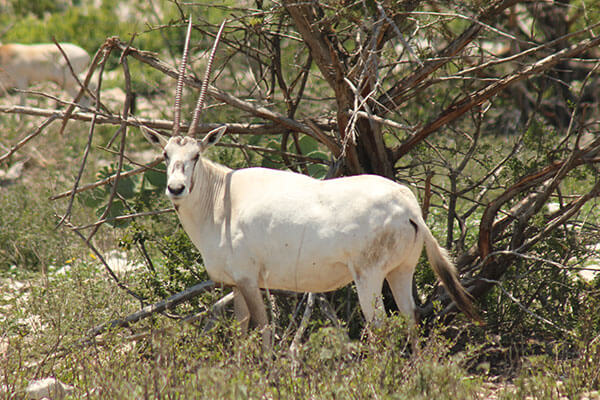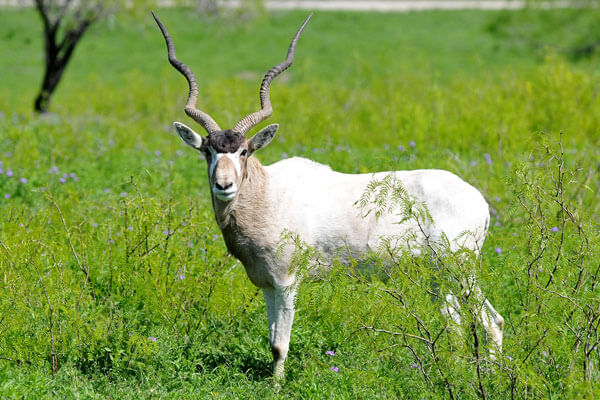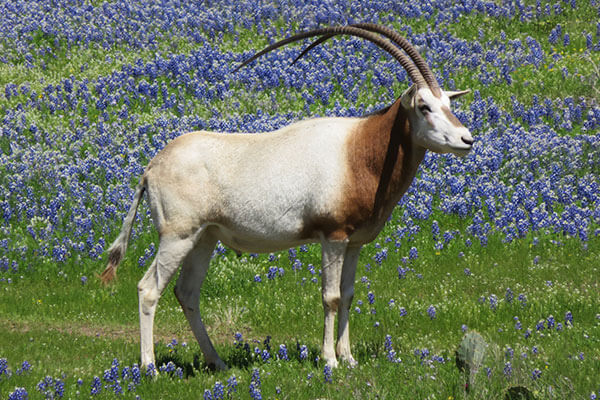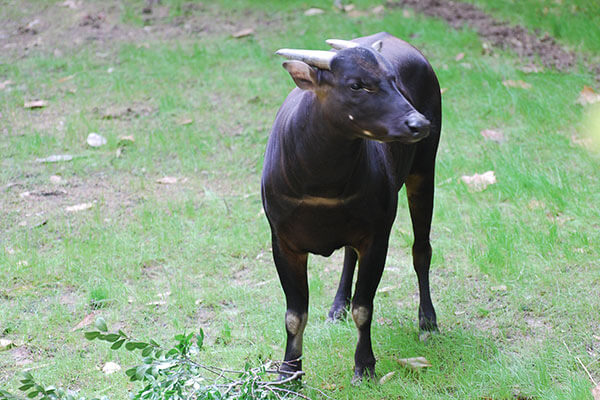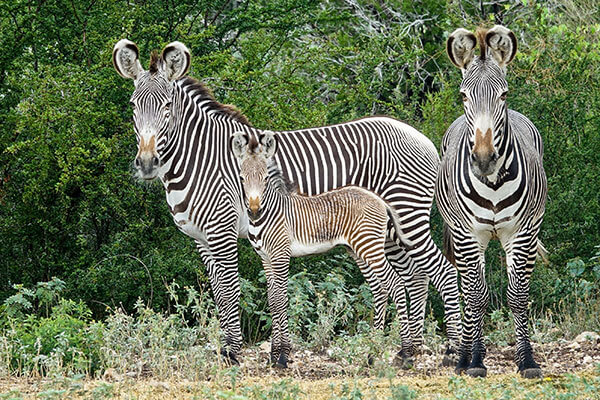Antelope
The Source Population Alliance (SPA) is a group of private landowners, Conservation Centers, and zoos who dedicate their unique resources to creating sustainable populations of wildlife that serve as dependable reservoirs for the conservation and use of animals in human care
and in the wild.
and in the wild.
ARABIAN ORYXORYX LEUCORYX
Conservation Status: Endangered SPA's strong North African Antelope species portfolio now includes the Arabian oryx. The Arabian oryx shares many similarities with the scimitar-horned oryx and addax, two of the SPA's original target species. IUCN estimates the population in nature is between 850 and 1200 animals, the majority being semi-wild animals living on preserves. The Arabian oryx does extremely well when raised in large natural herds on private lands. SPA's goal is to apply the same methodology of the original program species to the Arabian oryx, that is, linking all animals into a single, large metapopulation to ensure species survival into perpetuity. |
DAMA (ADDRA) GAZELLENANGER DAMA
Conservation Status: Critically Endangered, less than 100 The dama gazelle is critically endangered in the wild with less than 100 animals remaining. This desert gazelle species was chosen as a part of the SPA conservation portfolio because of the success we have seen with the species on private ranches. For a species with a wild population as low as the dama's, the work being done to raise the animals in human care is essential. Many SPA participants have built up large herds of dama gazelles and are committed to the survival of this species for many years to come. |
MOUNTAIN BONGOTRAGELAPHUS EURYCERUS
Conservation Status: Critically Endangered An ideal species for the SPA is the mountain bongo, due to its popularity with private landowners and a need for connectivity between the ranch and zoo communities. The Bongo population in nature is estimated by IUCN to be approximately 100 animals. The natural beauty and perilous status of wild populations makes the bongo a highly desirable species for all holders. There also are research opportunities, including through C2S2’s DNA Services. |
ROAN ANTELOPEHIPPOTRAGUS EQUINUS
Conservation Status: Least concern The selection of the roan antelope was based on its similarities with the sable antelope, already in the SPA’s portfolio. Although believed to be relatively safe in nature (perhaps as many as 75,000 animals according to IUCN), the roan antelope is highly dependent on availability of protected lands. Growing instability in some areas of its range makes the creation of insurance populations a high priority. Roan antelope are not as common in zoo or private collections as its sable counterpart, thereby also indicating the need for being included in our program. |
ADDAXADDAX NASOMACULATUS
Conservation Status: Critically Endangered; less than 100 The addax is critically endangered, with fewer than 100 animals remaining in their native range. Addax were chosen as one of the four original SPA program species because of their imperiled status in the wild and the success that has been seen with them on private ranches. Several SPA participant facilities have made addax a focus of their conservation breeding efforts, with herds of 30-70 animals not uncommon. Important in situ conservation work with this species is being done by Sahara Conservation Fund. |
SCIMITAR-HORNED ORYXORYX DAMMAH
Conservation Status: Extinct in the Wild The scimitar-horned oryx was one of the four original species of the SPA program. Scimitar were a logical fit for this unique conservation model with their IUCN status of extinct in the wild, and prevalence on private ranches in the U.S. There are estimated to be over 7,000 oryx on private ranches in the U.S. Oryx are not only of extremely high conservation value and beautiful, but they also thrive in human managed care. The scimitar-horned oryx is a desert species that once roamed large swaths of North African Sahel region until going extinct several decades ago. This unique animal now has a second chance at returning to their native range, and this is in large part because of the strong populations of these animals in human care in the U.S. and U.A.E. The Environment Agency Abu Dhabi and Sahara Conservation Fund are currently working to reintroduce this species back to Chad. Many SPA participant facilities have helped play a vital role in supporting this reintroduction efforts. Several staff members from our participants have made multiple trips to Chad to help with this project. Most recently, the SPA Program Manager and representatives from Fossil Rim, SCBI, and White Oak went to Chad in July, 2018 to assist with putting GPS collars on oryx slated for release. |
SABLE ANTELOPEHIPPOTRAGUS NIGER
Conservation Status: Least Concern While the IUCN classifies sable antelope as 'least concern', fewer than 75,000 of them remain in their native range. The wild population faces through from competition for grazing land and water sources with domestic livestock. Sable are a member of the genus 'Hippotragus' which means horse antelope. Sable antelope were chosen for the SPA program because they have a small zoo-managed population that needs to be increased, and are doing well on private ranches. By using sable genetic samples from zoos, conservation centers and private ranches, a customized targeted sequence capture panel was developed to study the genetic diversity in these different populations. Sable are an excellent example of a species that we can do valuable conservation work with, by building up the managed population, as a bulwark against extinction should they become endangered in their native range. |
Asian Wild Cattle
The Source Population Alliance (SPA) is a group of private landowners, Conservation Centers, and zoos who dedicate their unique resources to creating sustainable populations of wildlife that serve as dependable reservoirs for the conservation and use of animals in human care
and in the wild.
and in the wild.
ANOABUBALUS DEPRESSICORNIS
Conservation Status: Endangered with a fragmented population that is decreasing. The IUCN has been unable to accurately estimate the number of anoa in the range countries. However, we are confident that the population is being fragmented by habitat loss from deforestation and poaching. This is a species that will do well with the diverse participant base of the SPA. As with the banteng, our first step is determining which SPA members may be interested, while we simultaneously seek out new anoa stock for transfer. |
BANTENGBOS JAVANICUS
Conservation Status: Endangered with a fragmented population. The SPA will initially focus on the banteng by actively recruiting new individuals or organizations interested in helping conserve this unique, endangered species. The IUCN population estimate in nature is fewer than 8,000 individuals, with many of these living in fragmented, small, unsustainable populations. The current population of this species in the USA is held mostly in only a few facilities. Therefore, we need more banteng in more spaces. Besides creating a connected meta-population, there also are exciting research opportunities, including in assisted reproduction. C2S2 and SPA member the Wilds recently produced two banteng calves from artificial insemination. |
Equids
The Source Population Alliance (SPA) is a group of private landowners, Conservation Centers, and zoos who dedicate their unique resources to creating sustainable populations of wildlife that serve as dependable reservoirs for the conservation and use of animals in human care
and in the wild.
and in the wild.
GREVY'S ZEBRAEQUUS GREVYI
Conservation Status: Endangered The large space model of the SPA fits well with equids. Therefore, the Grevy's zebra has been added to the portfolio, because the wild population is probably no more than 2,000 individuals, declining more than 50% in the last 3 decades due to war and habitat loss. The Grevy's Zebra is an excellent addition to SPA because we believe it is relatively prevalent on private lands. The first step will be surveying to determine numbers of animals in the private sector and then beginning to link these herds to create a viable metapopulation. |

